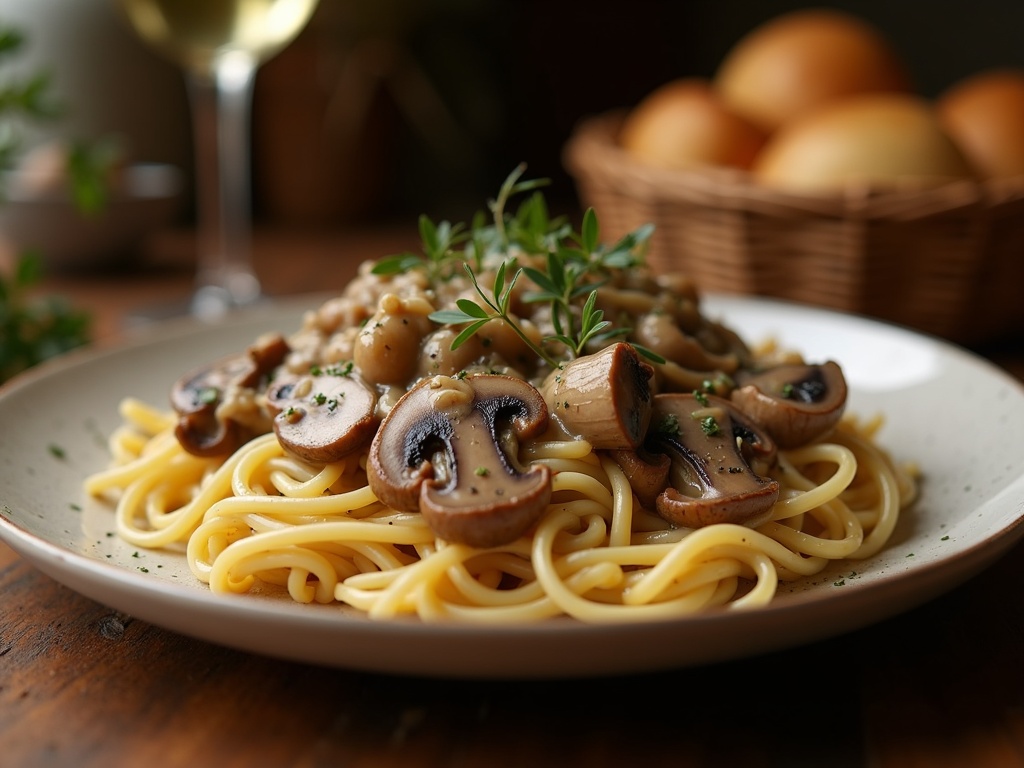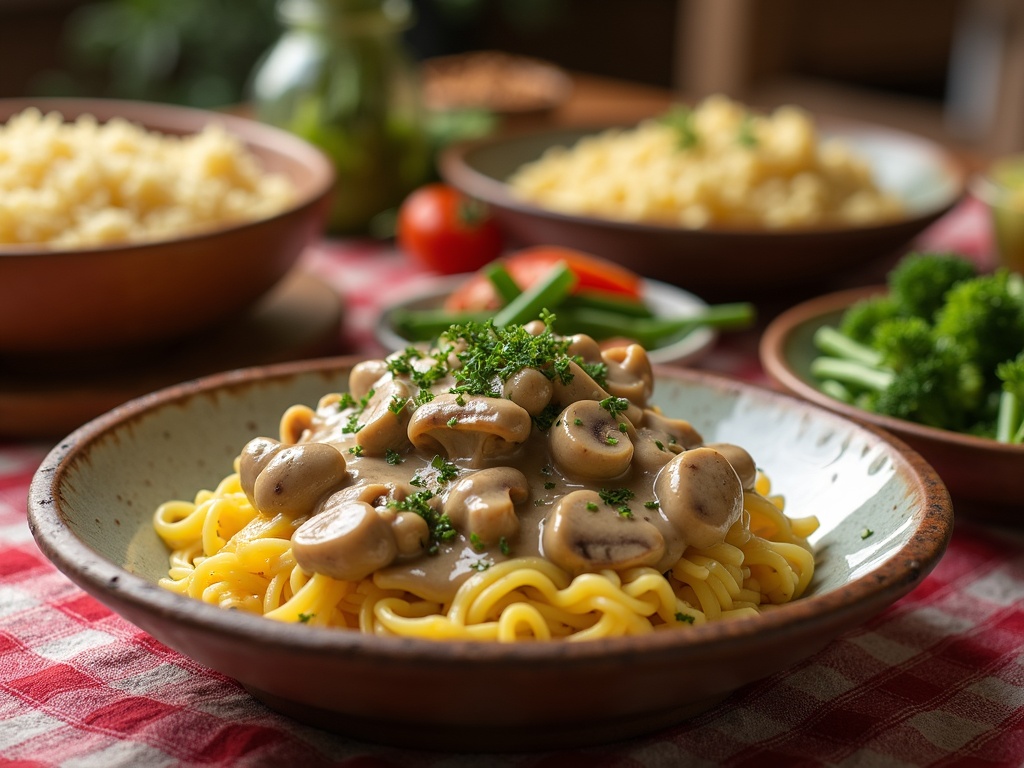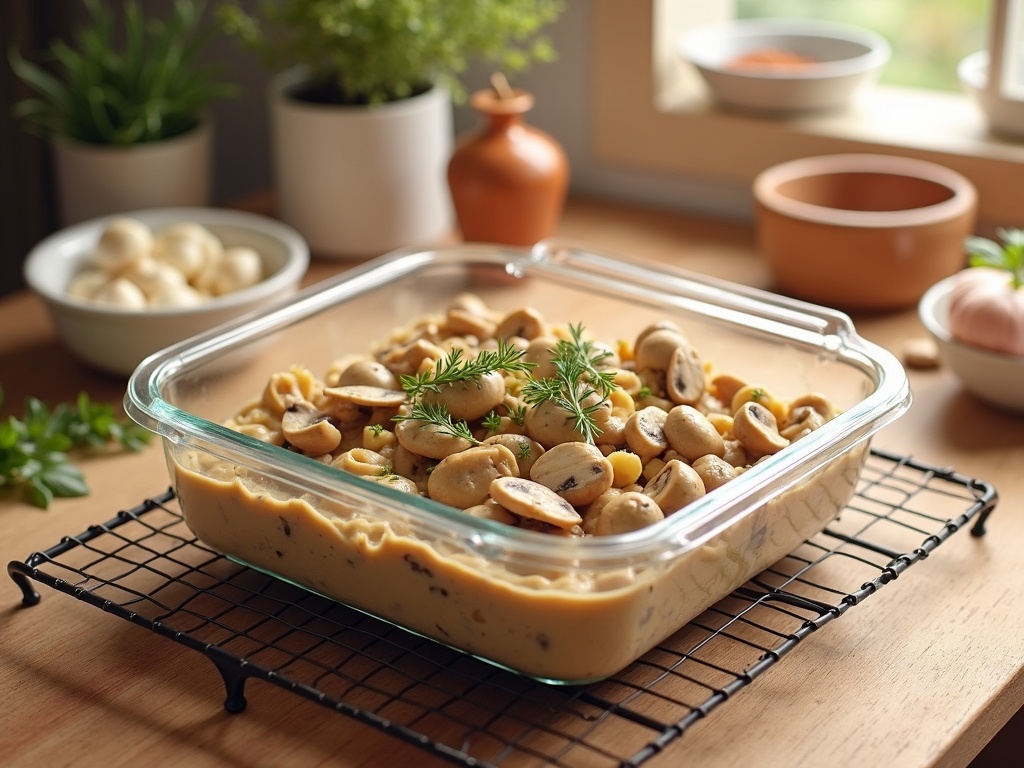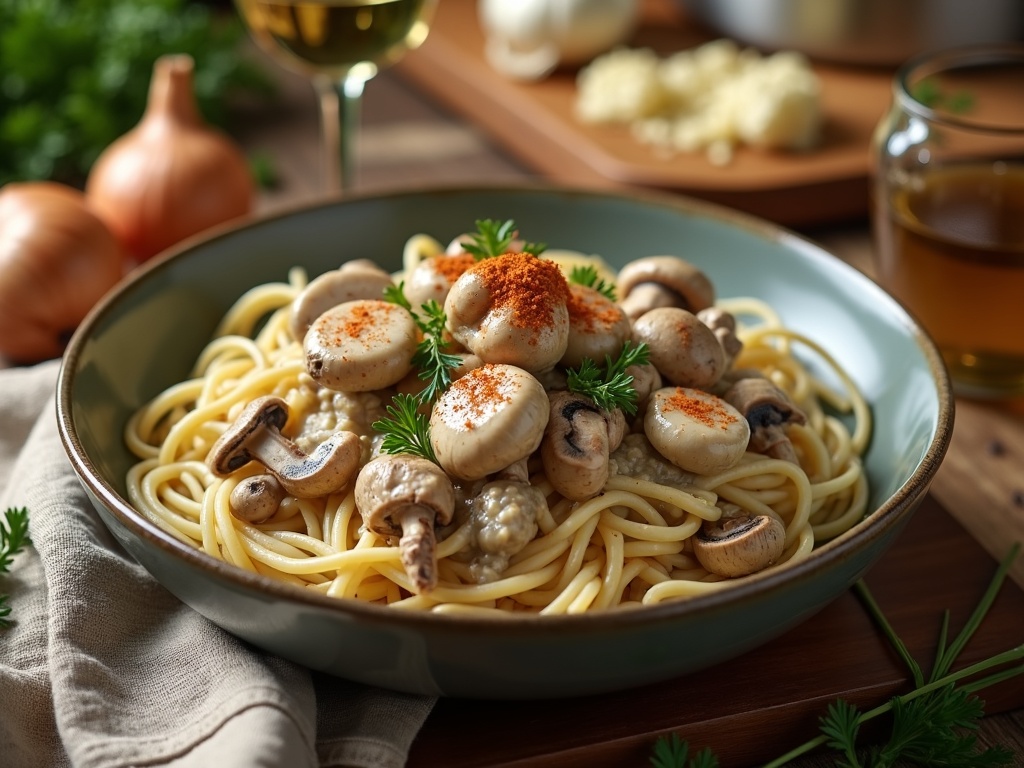Mushroom stroganoff has transformed from a simple beef alternative into a comfort food powerhouse, balancing rich flavors with notable health benefits. This dish combines earthy mushrooms with a creamy sauce to create a meal that satisfies everyone at the table – no compromises needed.
Find In This Article
Key Takeaways
- The dish’s success relies on using a variety of mushrooms (cremini, shiitake, portobello) to create complex flavors and meaty textures.
- Mushroom stroganoff provides impressive nutritional benefits with low calories, high vitamin content, and immune-supporting properties.
- Proper cooking techniques like sautéing mushrooms in batches and building flavor foundations elevate the dish to restaurant quality.
- The recipe easily adapts to dietary restrictions with vegan options using cashew cream or coconut milk instead of dairy.
- Leftovers often develop deeper flavors overnight, making mushroom stroganoff ideal for meal prep with proper storage techniques.
Why Mushroom Stroganoff is the Perfect Comfort Food
I can’t think of a dish that embodies comfort food better than mushroom stroganoff. This delightful meal traces its roots back to 19th century Russia, where it emerged as a vegetarian adaptation of the classic beef stroganoff. The transformation was brilliant – replacing meat with earthy mushrooms while maintaining the creamy, satisfying essence that makes stroganoff so beloved.
What makes mushroom stroganoff truly special is its universal appeal. It satisfies both dedicated vegetarians and meat-eaters alike, making it perfect for mixed dinner parties or families with varying dietary preferences. The dish doesn’t feel like a compromise for anyone at the table – meat-eaters rarely miss the beef because the mushrooms provide such a substantial, meaty texture.
A Symphony of Flavors and Textures
The magic of mushroom stroganoff lies in its perfect balance of flavors and textures. The mushrooms provide a deep umami richness that forms the foundation of the dish. This savory depth pairs beautifully with the creamy sauce, typically made with sour cream or crème fraîche, creating a velvety texture that coats each bite perfectly. I’ve found that mushrooms in creamy sauces create an irresistible combination that satisfies on multiple levels.
The dish combines several key elements that make it so crave-worthy:
- Mushroom variety: Using a mix of mushrooms (cremini, shiitake, oyster, or portobello) creates complex flavors and textures
- Aromatic base: Sautéed onions and garlic provide a fragrant foundation
- Tanginess: Sour cream adds a pleasant tang that cuts through the richness
- Balanced seasoning: Paprika, mustard, and herbs complement the earthiness of mushrooms
- Textural contrast: Served over pasta, rice, or potatoes for the perfect vehicle for the sauce
Over recent years, mushroom stroganoff has gained tremendous popularity across Europe and North America as people embrace more plant-based meals. Unlike many vegetarian adaptations that feel like pale imitations of meat dishes, stroganoff shines because mushrooms naturally provide the umami depth that makes the dish satisfying.
I’ve noticed that mushroom stroganoff features prominently on restaurant menus that want to offer sophisticated vegetarian options. It’s also become a staple in home cooking, especially for those embracing flexitarian diets or participating in movements like Meatless Monday. The dish provides that same creamy pasta comfort we all crave without requiring any meat.
What’s particularly wonderful about mushroom stroganoff is its accessibility. You don’t need culinary training to create a delicious version at home. The ingredients are readily available in most grocery stores, and the cooking process is straightforward. Even better, it’s ready in about 30 minutes, making it suitable for weeknight dinners when you want something that feels special without hours of preparation.
The dish’s popularity continues to grow as more people discover that vegetarian comfort food doesn’t have to feel like a compromise. Mushroom stroganoff delivers on all fronts – flavor, texture, satisfaction, and ease of preparation – making it the perfect comfort food for modern meals.

Health Benefits That Will Surprise You
I’m always amazed at how mushroom stroganoff combines comfort food appeal with impressive nutritional benefits. This savory dish delivers far more than just delicious flavors – it’s packed with nutrients that support overall health without weighing you down.
The star ingredient, mushrooms, contains only 15 calories per 100g, making them one of the leanest bases for a satisfying meal. When I create chicken and mushroom dishes, I’m always impressed by how these fungi add bulk and satisfaction while keeping the calorie count reasonable.
Nutritional Powerhouse
Mushrooms truly shine in the vitamin and mineral department. They’re naturally rich in vitamin D (especially when exposed to sunlight during growth), B vitamins for energy metabolism, selenium for immune support, and powerful antioxidants that help fight cellular damage. These nutrients work together to support your immune system, bone health, and energy levels.
A complete serving of mushroom stroganoff typically provides between 400-500 calories depending on your portion size and specific ingredients. This makes it a perfectly balanced meal option that satisfies hunger without excess calories.
When prepared with whole grain noodles, this dish becomes an excellent source of dietary fiber. I find this particularly valuable since fiber supports:
- Digestive health and regularity
- Steady blood sugar levels after meals
- Prolonged feeling of fullness
- Heart health through cholesterol management
- Gut microbiome diversity
The nutritional profile gets even more interesting when you consider mushroom varieties. Button mushrooms offer good basic nutrition, but specialty mushrooms like shiitake contain lentinan, which has immune-boosting properties. Portobello mushrooms provide extra potassium, while oyster mushrooms contain higher protein levels compared to other varieties.
What truly makes mushroom stroganoff stand out is its contribution to a balanced diet. The combination of plant-based protein from the mushrooms, complex carbohydrates from whole grain pasta, and moderate fat content from the creamy sauce creates a meal that satisfies without relying on meat. This makes it perfect for those looking to reduce meat consumption without sacrificing protein or flavor.
For an extra nutritional boost, I often add green vegetables like spinach or peas to my creamy pasta dishes including stroganoff. These additions increase the vitamin content while adding color and textural contrast.
Despite its creamy, indulgent taste, a well-prepared mushroom stroganoff can be surprisingly light compared to meat versions. The traditional beef stroganoff typically contains significantly more saturated fat and calories, making the mushroom version a heart-healthier choice that doesn’t sacrifice flavor.
The beauty of this dish lies in its balance – it delivers comfort food satisfaction while providing substantial nutritional benefits. I’ve found it’s an excellent way to introduce more plant-based meals into my routine without feeling deprived or hungry soon after eating.
By embracing mushroom stroganoff as a regular meal option, you’re not just enjoying a delicious dish – you’re actively supporting your body’s nutritional needs with a surprisingly beneficial combination of ingredients.
Master Chef Tips for the Perfect Stroganoff
Creating a mushroom stroganoff that impresses everyone at your dinner table isn’t complicated once you know the chef-level techniques. I’ve perfected this dish over years of experimentation, and I’m excited to share what makes the difference between an ordinary and extraordinary stroganoff. The best part? You’ll only need 30-45 minutes from start to finish.
Building Flavor Foundations
The secret to a memorable mushroom-based dish starts with proper layering of flavors. I always begin by sautéing onions and garlic until they reach a golden hue. This initial step creates a flavor foundation that permeates the entire dish. Don’t rush this process—those extra 2-3 minutes of caramelization make all the difference.
When adding mushrooms, I never dump them all in at once. Instead, I introduce them in batches to ensure each piece gets proper contact with the hot pan. This technique prevents mushrooms from steaming and guarantees they develop that rich, caramelized flavor that defines a great stroganoff.
For the best results, select cremini or portobello mushrooms as your stars. These varieties provide a meaty texture and robust flavor that button mushrooms simply can’t match. Before cooking, I clean mushrooms with a damp cloth rather than washing them—excess water is the enemy of proper browning.
Key ingredients that elevate your stroganoff include:
- Fresh cremini or portobello mushrooms (never canned)
- High-quality sour cream (full-fat provides the best texture)
- Sweet yellow onions, finely diced
- Fresh garlic cloves, minced just before cooking
For added depth, I often incorporate a splash of vegetable broth or white wine after mushrooms have browned. This deglazes the pan, capturing all those flavorful bits stuck to the bottom. Let this liquid reduce by half before adding your creamy sauce components for a concentrated flavor boost.
When selecting mushrooms, look for specimens with closed caps and no slimy texture. The freshest mushrooms have a firm feel and earthy aroma. For stroganoff, I slice them thickly (about ¼ inch) to maintain their substantial presence in the finished dish.
Dietary Adaptations for Every Need
I’ve discovered that mushroom stroganoff can be customized to fit almost any dietary requirement without sacrificing its rich, savory essence. The classic recipe traditionally features egg noodles bathed in a creamy sauce with sour cream, but numerous adaptations make this dish accessible to everyone at your table.
Plant-Based and Dairy-Free Options
The vegan version of mushroom stroganoff maintains the dish’s signature creaminess through clever substitutions. Instead of dairy-based sour cream, I use cashew cream that delivers a remarkably similar tangy richness. To prepare cashew cream:
- Soak raw cashews in hot water for 30 minutes
- Blend with a splash of lemon juice until silky smooth
- Add a pinch of nutritional yeast for a subtle umami boost
Coconut milk offers another excellent alternative, especially full-fat varieties that provide the necessary thickness for the sauce. For those concerned about coconut flavor overwhelming the dish, I’ve found that the earthiness of mushrooms actually balances it beautifully, especially when paired with a robust vegetable blend of onions and garlic.
Grain and Gluten Considerations
For those avoiding gluten, mushroom stroganoff adapts beautifully with a few simple changes. Specialty gluten-free pastas made from rice, corn, or quinoa provide an excellent foundation for the dish. I prefer brown rice pasta for its texture that holds up well under the hearty sauce.
The traditional flour-based roux can be replaced with cornstarch for thickening. I’ve found that mixing one tablespoon of cornstarch with two tablespoons of cold water creates the perfect slurry to achieve that classic stroganoff consistency. This works particularly well when making a creamy white sauce base for the mushrooms.
Beyond these specific adaptations, mushroom stroganoff welcomes personalization based on taste preferences. The mushroom selection itself can vary widely – portobello provides meatiness, while cremini offers delicate flavor. For a truly indulgent experience, mixing wild mushrooms with cultivated varieties creates depth similar to a gourmet mushroom pie.
The beauty of this dish lies in its flexibility. Whether you’re serving someone with lactose intolerance, gluten sensitivity, or plant-based preferences, stroganoff can be tailored without compromising on the comforting, rich experience that makes it a beloved classic.
Make It a Complete Meal
Transforming mushroom stroganoff from a standalone dish into a satisfying full meal is simple with the right accompaniments. I’ve found that the rich, savory flavors of this creamy mushroom dish pair beautifully with several base options and side dishes.
Perfect Pairings
The classic way to serve mushroom stroganoff is over egg noodles, which provide a fantastic texture contrast to the creamy sauce. The wide, flat noodles catch the sauce perfectly in each bite. If you’re looking for alternatives, fluffy white rice works wonderfully by soaking up all those delicious flavors. For a more indulgent option, serving the stroganoff over buttery mashed potatoes creates a comforting meal that’s hard to beat.
To balance the richness of mushroom dishes like stroganoff, I always add something green to the plate. A simple side salad with a light vinaigrette cuts through the creaminess and adds freshness. Steamed vegetables such as broccoli, green beans, or asparagus provide both nutritional value and color contrast to your plate.
For a balanced meal, aim for a portion that includes:
- 1 cup of stroganoff sauce
- 1 cup of noodles, rice, or mashed potatoes
- 1-2 cups of vegetables or salad
Don’t forget to add a finishing touch with some fresh herbs. A sprinkle of chopped parsley adds color and a hint of freshness, while snipped chives provide a mild onion flavor that complements the mushrooms beautifully.
For additional side dishes that pair well with mushroom stroganoff, consider garlic bread for soaking up extra sauce, or a light spinach soup as a starter. A simple cucumber and tomato salad dressed with lemon juice and olive oil offers a refreshing contrast to the rich main dish.
When planning your meal, keep in mind that mushroom stroganoff delivers earthy flavors and creamy textures, so choosing sides that provide contrast in both flavor and texture creates the most satisfying dining experience.

Storage and Meal Prep Secrets
Storing mushroom stroganoff properly makes a huge difference in how it tastes the next day. I’ve found that leftovers can actually develop deeper flavors overnight, making this dish perfect for meal prep. The key is knowing how to maintain that silky sauce texture and keep those mushrooms from becoming rubbery.
Storing Leftovers Like a Pro
When storing mushroom stroganoff, I always let it cool completely before transferring to an airtight container. This prevents condensation that can water down your sauce. For best results:
- Use shallow containers rather than deep ones to help the stroganoff cool quickly and evenly
- Store in the refrigerator for up to 3-4 days maximum
- Separate portions into individual containers if you plan to grab-and-go for lunches
- Add a piece of parchment paper directly on the surface of the sauce to prevent a skin from forming
The cream sauce tends to thicken significantly when refrigerated, which is perfectly normal. To restore it to its original glory, I add a splash of broth or milk when reheating. This helps maintain that luscious consistency that makes creamy dishes so satisfying.
Reheating for Maximum Deliciousness
Reheating mushroom stroganoff requires a gentle touch to preserve its texture and prevent the sauce from breaking. The microwave works in a pinch, but stovetop reheating gives superior results.
On the stovetop, I place the stroganoff in a pan over medium-low heat with a tablespoon of water or broth. Stirring frequently prevents the sauce from sticking or separating. This method maintains the integrity of both the mushrooms and the sauce.
For microwave reheating, cover the dish and use 50-60% power in short intervals, stirring between each. This slower approach helps prevent the sauce from becoming oily or separated.
Freezing mushroom stroganoff is possible but requires special attention. The cream sauce can separate when thawed, so I recommend these tips for freezer storage:
- Slightly undercook the mushrooms if you know you’ll be freezing the dish
- Cool completely before transferring to freezer-safe containers
- Leave about an inch of space at the top of containers to allow for expansion
- Thaw overnight in the refrigerator before reheating
- Gently reheat with additional liquid to help recombine the sauce
Meal prepping mushroom stroganoff can be a game-changer for busy weeknights. I often prepare the mushroom mixture on Sunday and store it separately from freshly cooked pasta or rice. This gives me a head start on dinner without compromising on quality.
For an even quicker weeknight option, try prepping all your ingredients in advance. Clean and slice mushrooms, chop onions, and measure out spices ahead of time. Store these prepped ingredients separately in the refrigerator, and dinner assembly becomes much faster.
Consider making a double batch of the mushroom portion of your stroganoff. Use half for your immediate meal and transform the second half into a completely different dish later in the week – perhaps as a topping for baked potatoes or folded into a white sauce pasta for variety.
With these storage and prep techniques, mushroom stroganoff can become a versatile part of your meal rotation. The earthy mushrooms and creamy sauce make for a comforting dish that often tastes even better the next day, making those few extra minutes of proper storage well worth the effort.

Sources:
“The Stroganov Family: A Historical Account.” Historical Cuisines Journal
“Nutritional Analysis of Common Fruits and Vegetables.” Nutrition Today
“Vegetarian Cooking Techniques and Ingredients.” Culinary Arts Review
“Innovative Mushroom Recipes for Modern Cooks.” Modern Kitchen Chronicles

